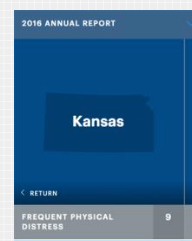By AMIE JUST
Brandon Johannes knew he was dying.
As Johannes and his brothers toured Alcatraz in 2011, his view of The Rock was slightly different than planned.
“I can tell you where every bench was on Alcatraz,” Johannes said, “because that was the tour of Alcatraz for me.”
After a few minutes of walking, Johannes, then 31, needed a place to sit and rest. Shortness of breath and back strain made daily routines such as standing and walking incredibly difficult.
At 6-foot-1 and 500 pounds, he was nearly three-times the size of the average man his height. Johannes’ body mass index was 66. On most BMI charts, obesity starts at 30. Johannes’ belt was more than 5 feet tall — longer than some of his friends were tall.
While walking throughout San Francisco, drenched in sweat, Johannes would fall blocks behind his physically fit brothers.
Johannes’ brothers, Aaron and Matt, are both taller than Brandon. Aaron, is 6-foot-3 and weighed approximately 175. Matt, the tallest of the three, is 6-foot-7 and weighed approximately 260.
For 14 years, Johannes had deflected comments from his family and friends telling him that he needed to lose weight. His response was always the same: “I’m not ready yet.”
Alone on an Alcatraz bench, with his brothers out of sight, Johannes realized it was time for a change. He couldn’t ignore his obesity anymore; he needed weight-loss surgery.
Johannes, a Leavenworth resident, was far from alone.
According to the national 2015 State of Obesity report, obesity rates increased in two states: Kentucky and Kansas. With Kansas’ latest increase, the state now ranks seventh nation in highest obesity percentage at 34.2 percent.
Over the past 20 years, the percentage of obese Kansans has increased 153 percent. In 1995, Kansas’ obesity percentage was 13½ percent, ranking 36th nationwide.
A combination of issues has contributed to Kansas’ precipitous increase in obesity, but experts are unable to pinpoint a direct cause.
“It would be great if we could wave a magic wand and identify and pinpoint the exact issue for obesity rising in Kansas,” said Kate Hoppe, the Physical Activity and Nutrition Manager for the Kansas Department of Health and Environment’s Bureau of Health Promotion. “The fact of the matter is that obesity is a pretty complex issue. Body weight is the result of many factors, including behavior, metabolism and genetics.”
During the past eight years, one of First Lady Michelle Obama’s cornerstone initiatives has targeted healthy eating habits. Her Let’s Move! campaign promotes raising a healthier generation of children.
But that program, and others like it, is for kids, not adults.
In 2015, roughly one in five adults 18 years and older ate vegetables less than one time per day, according to the Kansas Behavioral Risk Factor Surveillance System. That number was even higher for fruit, as about two in five adults for that same age group ate fruit less than once daily. Those numbers aren’t significantly different than 2013.
There’s also a difference between not eating healthy foods and being addicted to eating.
In the fifth edition of the Diagnostic and Statistical Manual of Mental Disorders, food addiction, otherwise known as “Binge Eating Disorder,” is now recognized as its own category of eating disorders. It joints other disorders such as Anorexia Nervosa and Bulimia Nervosa.
Food addiction
Sometimes twice a day, Johannes would venture to McDonald’s. For breakfast, he’d have the Deluxe Big Breakfast with scrambled eggs, sausage and pancakes. He’d also get two bacon, egg and cheese biscuits with hash browns, as well as several breakfast burritos. For lunch or dinner, Johannes would order two double cheeseburgers to eat on the drive home as an appetizer. Upon arrival, he’d eat a double quarter pounder meal with supersized large fries as his entree.
When he’d have pizza for dinner, it wouldn’t be a slice or two. He’d eat an entire large Meat Lovers pizza with stuffed crust from Pizza Hut in a single sitting.
According to Pizza Hut’s menu, that’s 3,840 calories.
“I can’t think of any place that I used to go where I didn’t usually double up,” Johannes said. “I was eating upwards of 2,500 to 3,000 calories a meal.”
According to the U.S. Department of Agriculture, on average men should consume about 2,500 calories daily.
Johannes had a problem. He was addicted to food.
“One of the things about this particular addiction is that you can live without alcohol. You can live without hard drugs. You can’t live without food,” Johannes said. “You don’t get days where you’re sober. You’ve gotta stick with your drug every day until the day you die.”
While Johannes was eating high quantities of food well above the recommended amount of trans and saturated fats, his cholesterol was through the roof at 238. Any higher than that is considered extremely dangerous. He’d been on medicine to help regulate it for over a year. In addition to medication, Johannes preemptively took an additional medication for 13 months in hopes of staving off diabetes.
A week after Johannes scheduled his bariatric surgery, his doctor called. He had officially crossed the diabetic line.
Johannes’s health problems didn’t stop there. He’d been diagnosed with high blood pressure, gout and enlarged organs.
“There was a point in time where my doctor was worried that my pancreas wasn’t even functioning,” he said.
To this day, he has weak knees and ankles because of the weight he carried for the better part of 14 years.
All told, Johannes was taking at least six different medications for his various health conditions related to obesity, plus at least two more for unrelated medical conditions.
“I had a lot of different side effects and it was only getting worse the older I got,” he said. “I don’t know if I would have made it to my 40s or 50s and if I had, oh my goodness, the kinds of stuff I would have been on then.”
In the state of Kansas, nearly 10 percent of adults have been diagnosed with diabetes and 31.6 percent of adults have been diagnosed with hypertension. Both of those figures are approximately median figures nationwide.
To compare, Colorado has the lowest adult diabetes rate in the union at 6.8 percent, while Mississippi bolsters a rate of 14.7 percent to lead the nation. Utah has the lowest adult hypertension rate at 23.6 percent. West Virginia leads the nation in hypertension rates at 42.7 percent.
Currently, approximately 558,000 adult Kansans have hypertension and 239,000 adult Kansans have diabetes. If the rates continue to increase at the current pace, over 700,000 adult Kansans will have hypertension and 367,000 adult Kansans will have diabetes in 2030.
The entire population of Johnson county in 2012 was roughly 559,000 people.
According to the 2012 “F as in Fat” report, there were over 176,000 heart disease cases in the state of Kansas in 2010. If the projection numbers remain on course, by 2030, more than 769,000 adult Kansans will be diagnosed with a heart disease. That would be the entire population of Kansas City, Kan., Wichita, Topeka and Manhattan combined.
“Quite a lot of health professionals are concerned about obesity rates because they feel like it’s going to bankrupt the health care system,” said Marty Glenn, a registered and licensed dietician and lecturer at the University of Kansas. “ Because of the cost involved for treating all these diseases, especially diabetes because it affects a lot of different parts of the body. You have to go see a specialist for every body part almost.”
State of Obesity report
The main unit of measurement for the annual State of Obesity report is body mass index. To calculate BMI, all it takes is knowing someone’s height and weight. But it’s not a perfect measurement.
Glenn, and many medical professionals, aren’t keen on using BMI as a measure for obesity.
“It’s very, very practical, but it’s just flawed,” Glenn said. “It’s too general. I am not a huge fan of the BMIs at all. I think they over estimate how many people truly are unhealthy.”
Some people, such as athletes, are more likely to have higher BMIs because muscle tissue is dense and heavier than fat tissue.
Glenn said muscle tissue is like a sponge that’s been soaked in water, whereas fat tissue is a dry sponge.
“It’s still the same size, but the weight because of the water content is much higher,” he said. “You get somebody, like (Cleveland Cavaliers) LeBron James, and about any player in the NFL and they’re going to be obese or at least overweight.”
It’s true. James’s calculated body mass index is 27.4, indicating someone who’s overweight. But his body composition was 6.7 percent body fat in 2003. According to BMI, New England Patriot quarterback Tom Brady is overweight, while Patriots tight end Rob Gronkowski and Green Bay running back Eddie Lacy are obese.
Glenn wishes that there was a more practical way to assess whether or not someone’s weight was unhealthily overweight or obese or healthily overweight or obese.
Even though Glenn has qualms with the main measurement used for the study, he doesn’t dismiss that obesity is truly a problem in Kansas.
“They’re moving up the ranks that’s for sure,” Glenn said. “Unfortunately those are rankings you don’t want to slowly move up, but they have been.”
Kansas solutions
Back in 2006, then-Kansas Governor Kathleen Sebelius reinstated the Kansas Governor’s Council on Fitness that was abolished in 1995. Its mission is “to encourage physical activity, healthy diets and tobacco use prevention by sharing information with Kansans and partnering with businesses, schools and individuals to promote healthy lifestyles.
The Governor’s Council on Fitness is still active and has 18 current members including the Secretary of Health and Environment, the Chief Operating Officer of Blue Cross and Blue Shield of Kansas Foundation, professors at Fort Hays State and the University of Kansas School of Medicine, among others.
One of their main goal is working on the Healthy Kansans 2020 plan by focusing on 12 different areas related to health by building “on the comprehensive, nationwide health promotion and disease prevention agenda” and “to establish state-specific measures and initiatives.”
Those 12 areas include: access to health services, chronic disease, disability and health, environmental health, immunization and infectious disease, injury prevention, lifestyle behaviors, maternal, infant and child health, mental health, oral health, social determinants of health, and violence prevention.
But this wasn’t just a Kansas initiative. The Healthy Kansans 2020 plan derives from the national Healthy People 2020 plan.
The Kansas-oriented plan has two objectives related to obesity. One is to reduce the proportion of Kansans who are obese to 30.5 percent. The other is to reduce to the proportion of Kansas adolescents aged 12 to 19 who are obese to 16.1 percent. The current rate of adolescent obesity, according to the Center for Disease Control, is 16.3 percent. The plan doesn’t outline how those objectives are going to be achieved, other than by “promoting access to healthy foods and support policies that promote healthy food choices.”
The Kansas Department of Health and Environment is currently supporting other initiatives as well, according to Hoppe, such as, increasing access to local foods by increasing the number of farmer’s markets and farm to institution programs, as well as, increasing physical activity among all populations by implementing pedestrian and bicyclist plans to further implement sidewalks and bicycle lanes.
“Another thing that I think complements these efforts too that’s really important is that we’re supporting evidence-based lifestyle change programs across the state,” Hoppe said. “What those programs do is give people with chronic conditions the tools to make and sustain lifestyle changes that will help them to be healthier.”
A real-world example Hoppe mentioned is the incorporation of a new grocery store to Allen County.
Back in May 2015, it was announced that a grocery store company submitted a letter of intent to build in Iola. The press release announcing the plans said Thrive Allen County– a non-profit devoted to healthy living– had been trying to get a new supermarket built in the area since January 2013. According to Hoppe, the purchase of the land was conditioned on adopted design standards to make the area walkable and bikeable. The official groundbreaking of the grocery store was on Oct. 27, 2016.
In addition, Hoppe also outlined a new wayfinding plan in Sedgwick County. The plan provides signage for pedestrians and cyclists to healthy food retailers and health clinics.
“I think that this work highlights the importance of these strategies that we’re working on and our communities are working on for not only increasing physical activity and healthy eating but also ensuring that underserved and high-risk populations have physical access to needed health care services that can assist them with managing their obesity or other chronic conditions,” Hoppe said.
The first meeting in regards to the Wichita Bicycle Wayfinding System occurred in early June 2015. The most recent meeting, according to the wichita.gov website occurred in March 2016, but no minutes were posted. According to the October 2015 meeting minutes, the wayfinding system master plan was supposed to be finalized in February 2016, The final system plan was dated Sept. 13, 2016. That doesn’t include a final date for when the nearly additional side paths, bicycle lanes and shared use paths will be completed. The master plan says 770 miles of bicycle facilities are recommended. The wichita.gov website says the city currently maintains more than 100 miles of bicycle facilities.
But these programs aren’t quick fixes. Most, if not all of them, require years of planning, years to execute and additional years to see concrete results.
“We’re confident we know that based on the evidence that these strategies do make an impact on population health, it just takes some time,” Hoppe said.
Amie Just is a University of Kansas senior from Funk, Neb., majoring in Journalism and Mass Communications.
 Last week’s inspection results from the Kansas Department of Agriculture:
Last week’s inspection results from the Kansas Department of Agriculture:


















 By GARRETT SAGER
By GARRETT SAGER